Commitments Quick Reference Guide
This topic provides a reference for working with Project Center commitments.
Click here to download a PDF of the reference guide.
Purpose
A “commitment” is a contractual obligation to pay another company, such as a supplier, subcontractor or consultant. In Project Center you can track the complete commitment workflow in the Contracts, Potential Change Orders, and Change Orders activity centers.
Audience
Project team members involved in contract management and administration including project managers and subcontractors.
Key Features
● Create and track contract scope including cost code-level of detail for contract financial commitments.
● Create contract, potential change order (PCO), and change order documents ready for signature using customizable Word templates.
● Manage PCOs affecting contracts, request and track pricing, and understand the big picture from the PCO Scoreboard.
● Create change orders from one or multiple PCOs and track the review and approval workflow.
● View summarized information of the contract’s financial status, including all change orders and PCOs, and quickly drill-down into the related documents that compose the financial forecast.
Tasks covered
● Forward the contract for review and signature
● Record the reviewer response for the contract
● Link the executed contract file
● Close (finalize) the contract
● Create a potential change order (PCO)
● Generate a letter to request pricing for the PCO
● Track and analyze PCOs and commitments
● Turn PCOs into change orders
● Merge the change order document
● Forward the change order for review or signature
● Record the reviewer response for the change order
● Close (finalize) a change order
● Close (finalize) a potential change order
Initial Considerations
Before you create a contract record, you should consider doing the following:
1. Create Cost Codes (Required). Cost codes are required when entering a Schedule of Values for a contract. In the Cost Codes activity center, add codes individually or use the Import Spreadsheet utility to create in bulk.
2. Add Contract Documents in the Document Control activity center (Optional). Drawings, specifications, and contract exhibits provide the legal description of construction contracts. If you are using Newforma to generate contracts for signature, the current revisions of these documents should be tracked in the Document Control activity center so they can be added into the contract record. Optionally, the files can be transmitted along with the merged contract document, PCOs, and/or change orders.
Process overview
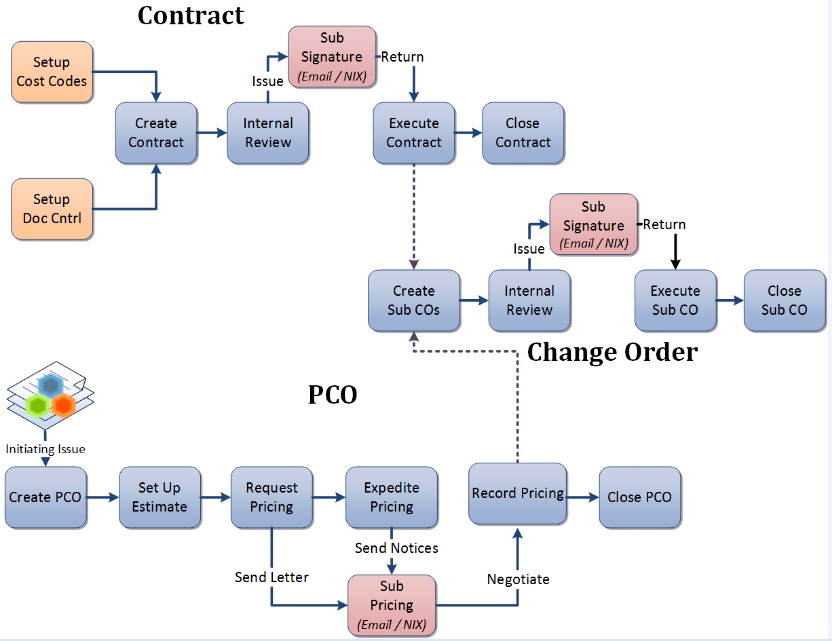
To create a contract
1. In the Contracts activity center, click New Contract > Create Contract on the Tasks panel.
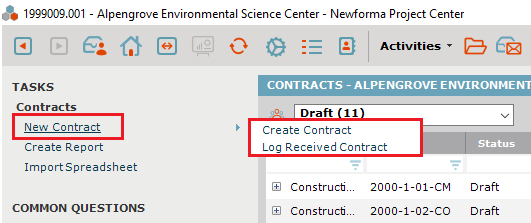
2. In the Create Contract dialog box, fill in required fields such as Subject, To Company, and From Company. If you want to create a contract document for signature through Newforma, select the correct Form Template. Complete any other detail fields.
There are three default Word form templates provided. Each can be customized and/or you can create your own templates.
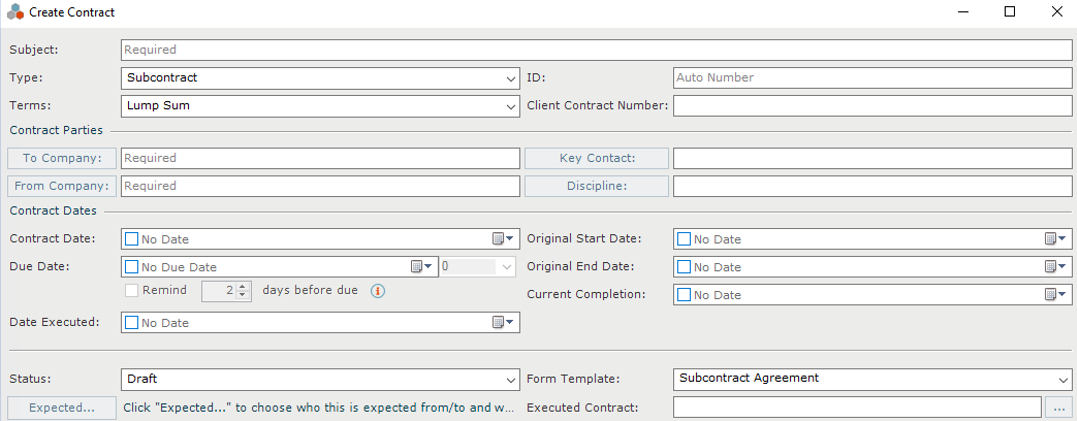
3. Select the Schedule of Values tab to add commitment items to the contract. Click the Add New button to add a new row, select Cost Code (required), enter the Item Description and Commitment amount. Add more line items for a detailed breakdown of the contract amount. The Total Commitment is displayed at the top of the grid.

If you are creating a contract record just to track a log of contract values, then this may be the only tab that is needed. The remaining steps in this section are primarily used if you are generating the contract documents for signature from Newforma.
4. Select the Scope tab to describe the work that is included in the contract. Click on the button to the far right of each section to enlarge the field. This information can be merged into the contract document (except for Internal Notes).
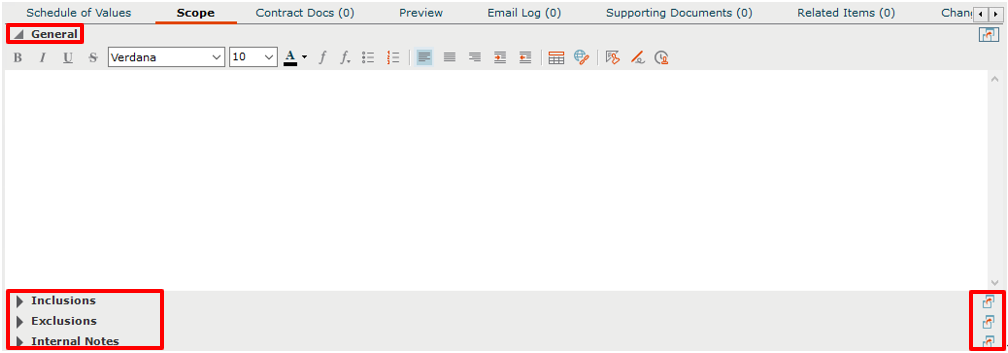
5. Select the Contract Docs tab to add specific revisions of record documents from the Document Control activity center. These are the drawings, specifications and contract exhibits that form the legal basis of the contract. These files can be sent along with the merged contract document.

6. Click OK when done to save the contract record.
To merge the contract document
Once you have created the contract record, you can optionally create the contract document to be sent for signature using one of the default Word form templates, or using a form template you have customized or created.
1. Before you can create the contract document, the correct form template must be selected in the Form Template field on the contract record.
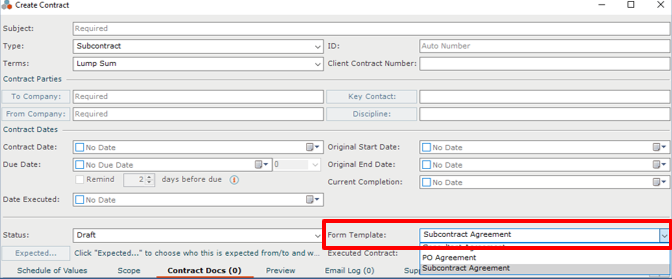
2. Select the contract from the log view and click View Form from the Tasks panel.
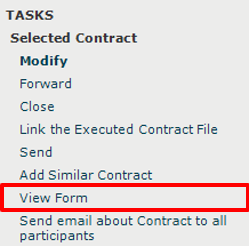
3. The resulting merged contract document appears. You can Print, or use the Save As button to save the file. If you are ready to take the next step, click the Next Action button and either Forward (for review or signature) or Send (if no response is required). This creates a PDF of the contract and attaches it to the Forward Contract workflow step.

To forward the contract for review or signature
If you did not use the Next Action option in the previous step, you can use the separate Forward task to send for review or signature.
1. Select the contract from the log view and click Forward from the Tasks panel.
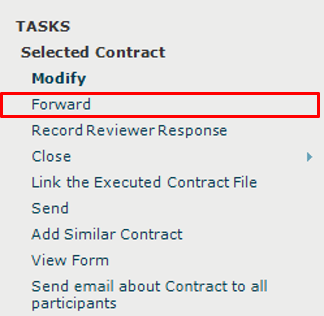
2. The Select Files to Forward for Review dialog box opens. Select the contract document(s) and/or other files to forward, select the forwarding method (Info Exchange or Email), then click OK.
3. The Forward Contract dialog box opens. Edit any information as needed and click the Forward button.
4. If Info Exchange was chosen as the forward method, fill out the Info Exchange options and click OK to complete the transfer.
To record the reviewer response for the contract
When the reviewer response is received, it can be recorded as a workflow action for the contract. Reviewer responses can originate from Info Exchange, email, mail, etc., or from internal staff.
1. If internal staff is recording their review, select the contract and click Record Reviewer Response from the Tasks panel, then go to step 3 below.
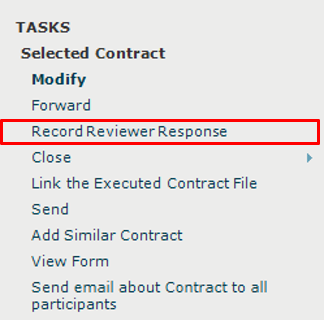
2. If the review response is coming from Info Exchange, it will be in the Pending Incoming log. Select the incoming response and click Receive Pending Review Response to receive it.
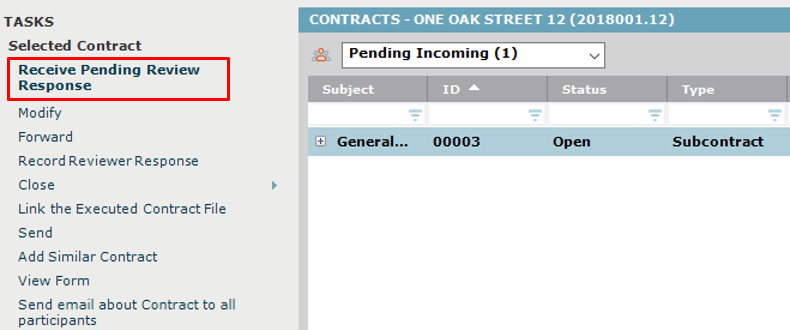
3. The Record Reviewer Response for Contract dialog box opens. Review the information, and then click Record Response.
To link the executed contract file
Once the contract is finalized and signed, you can link the signed, scanned file to the contract record.
1. Select the contract in the log and click Link the Executed Contract File from the Tasks panel. Browse to find and select the file.
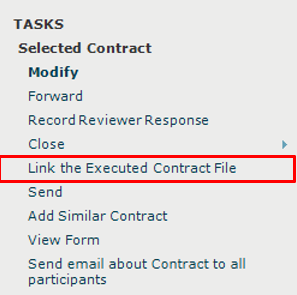
To close (finalize) the contract
After the contract is reviewed and contract documents have been signed and saved, you can take the next workflow action to close (finalize) the contract to indicate that the contracted work can begin.
1. Select the contract and click Close > Send and Close from the Tasks panel to send it to the parties involved.
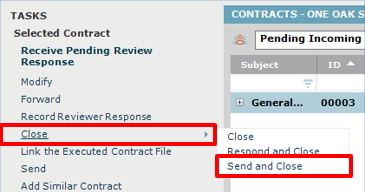
2. The Select Files to Send dialog box opens. Select the contract document(s) and/or other files to send, select the method (Info Exchange or Email), then click OK.
To create a potential change order
Use the Potential Change Order activity center to track issues that could possibly change the signed and finalized contract.
1. To create a new potential change order (PCO) record, go to the Potential Change Orders activity center and click Create Potential Change Order from the Tasks panel.
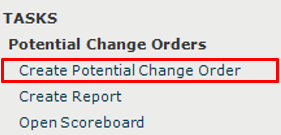
2. In the Create Potential Change Order dialog box, fill in any required fields such as Subject, and then fill in any other details.
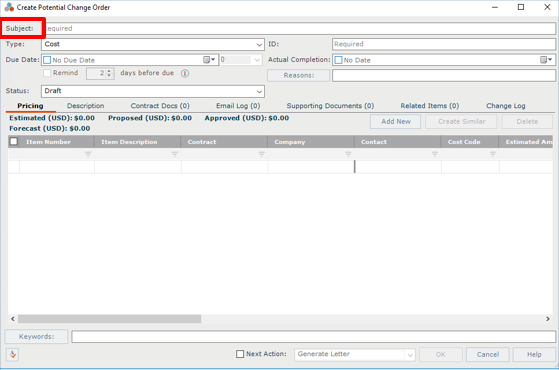
3. Click the Pricing tab to add pricing data for the PCO. Click the Add New button to add a new row, and fill in an Item Description, Contract, Cost Code, and Estimated Amount. Repeat the process for each line you want to add. Use the Create Similar button to save data entry time for new rows added.
If a contract is selected, only cost codes assigned to that contract are available. If no contract has been selected for internal cost items, click the button in the cost code field to browse and select the appropriate cost code.
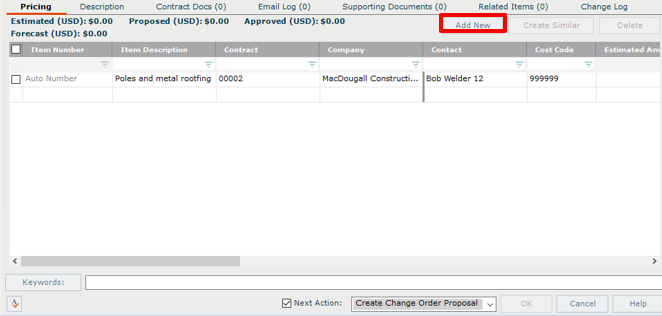
4. Click on the Description tab to enter any general information about the PCO. Use the Internal Notes section to record any notes you do not want to be seen by external parties.
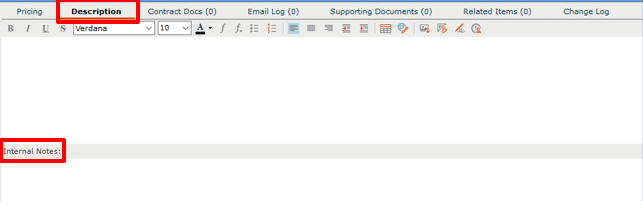
5. Click on the Contract Docs tab to add specific revisions of record documents from the Document Control activity center. These are the drawings, specifications, or contract exhibits that relate to the PCO. Background information that the subcontractors need in order to prepare their estimates can also be attached to the Supporting Documents tab.

6. Click OK when done to save the PCO.
To generate a letter to request pricing for the PCO
Once you have created the PCO record with all applicable information, you can optionally create a letter to request pricing using one of the default Word form templates, or using a form template you have customized or created.
1. Select the PCO from the log view and click Generate Letter from the Tasks panel.

2. The Generate Letter dialog box opens. Select the Pricing Items you want to include. Then select the Form Template you want to use and the Format. Put in an Output Filename only if you want it to be called something other than the default name. Indicate a location in the Save In field for the letter only if you want it saved in a different place than the default location.
Click the Preview button to see the information merged before sending. If you are ready to send it, select the Next Action checkbox and select Send from the drop-down. Click OK.
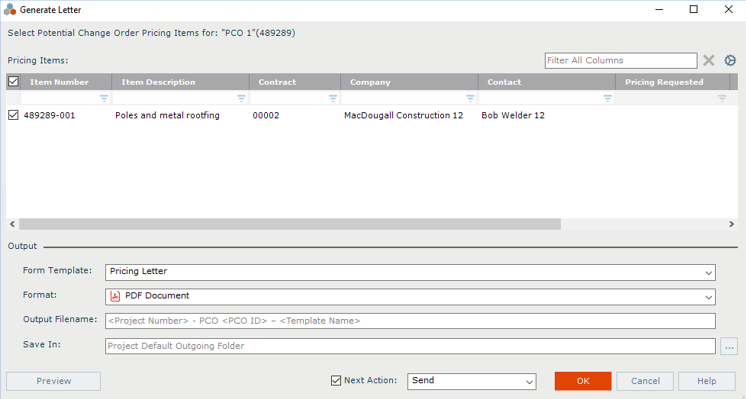
3. In the Send Options dialog box, indicate how you want to send the document (Info Exchange or Email) and whether you want to create a project transmittal.
4. In the Select Files to Send dialog box, you can optionally include the contract documents and/or supporting documents in the transfer along with the merged letter. Click OK to transfer the letter.
5. Select the PCO in the log and click Modify from the Tasks panel. On the Pricing tab, indicate the date you requested pricing in the Pricing Requested field, the Pricing Due Date, and Reminder Days.

6. You can also change the Status on the main PCO record to indicate that pricing has been requested.
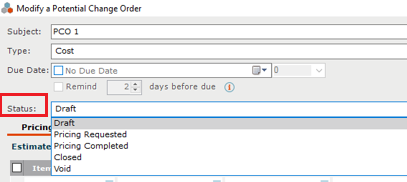
To record pricing for the PCO
Once you have created the PCO record with all applicable information and requested pricing, as proposed pricing comes in you need to record it and track the status of all your PCOs.
1. If the subcontractor responds via the Info Exchange website, the Pricing Received date, Proposed Amount, and Proposed Days will flow into the PCO line items automatically. If you receive pricing via email, verbally, or in person, you will need to fill in the information yourself.

2. Once all pricing has been received, you can change the Status of the PCO to Pricing Completed.

3. Once final amounts have been negotiated and agreed upon, fill in the Approved Amounts (and if needed, Approved Days) in order to create a change order.

Note: If any line on a PCO is not approved, enter zero in the Approved Amount field.
To track and analyze PCOs and commitments
1. To see an instant on-screen analysis of potential change orders for tracking purposes, go to the Potential Change Order activity center and click Open Scoreboard from the Tasks panel. The scoreboard helps identify which pricing items need to be expedited. To print information from the scoreboard, click Generate Report.
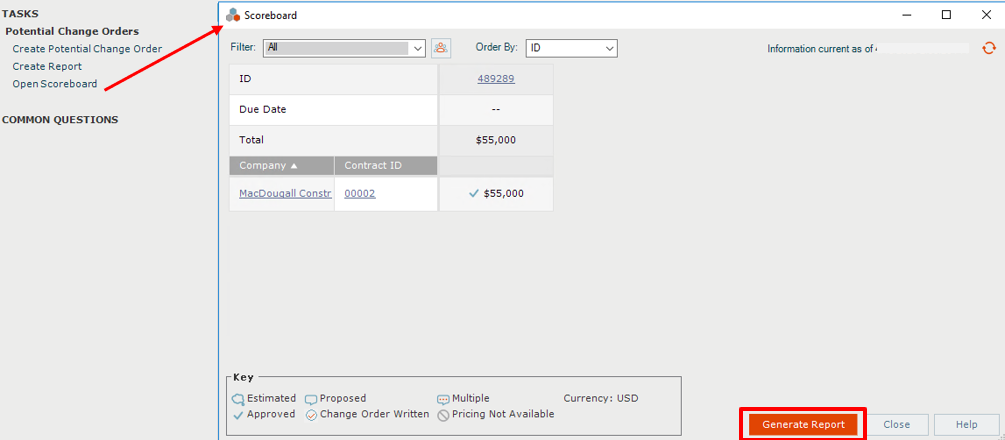
2. To see an instant on-screen analysis of commitments for a contract with a pie chart and summarized view of change orders and potential change orders, go to the Contract activity center, select the contract, and click the Summary tab.

To turn PCOs into change orders
To finalize the agreement with a change order to the subcontractor, go to the Change Order activity center to create it.
1. In the Change Order activity center click New Change Order > Create Change Order on the Tasks panel.

2. In the Create a Change Order dialog box, fill in any required fields such as Subject, Contract, To Company and From Company. Select the correct Form Template, and then fill in any other details.
The Contract field is required if you are adding a Schedule of Values.
There are two default form templates provided. Each can be customized and/or you can create your own templates.
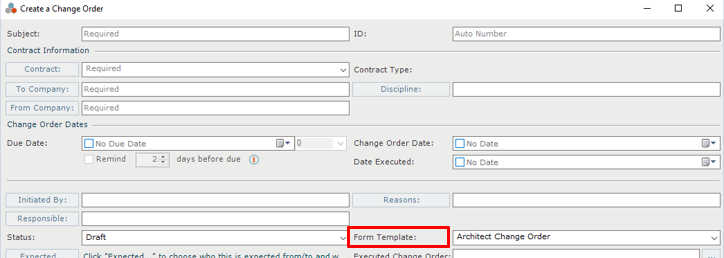
3. Click on the Schedule of Values tab and click the Add button to add rows.
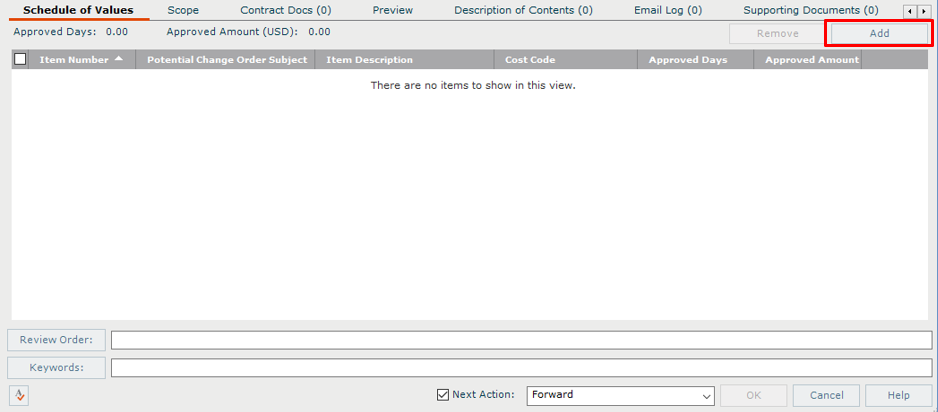
4. The Select Potential Change Order Pricing Items dialog box allows you to select any pricing item that is tagged to the selected contract and has an approved amount entered.

5. Click on the Scope tab to enter detailed information about what is included and not included in the change order, as well as other general information. Click the button to the far right of each section to enlarge the field. Use buttons on the toolbar of each section for formatting text. This information will merge into the change order document (except for Internal Notes).
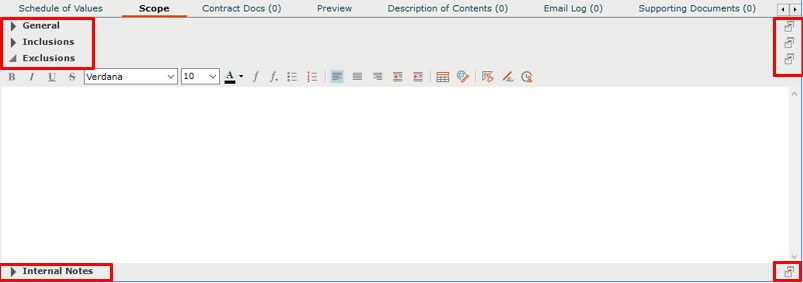
6. Optionally, you can click on the Contract Docs tab to transmit record documents related to the change order.

7. Fill information on other tabs as needed. Click OK when done to save the change order record.
To merge the change order document
Once you have created the change order record with all applicable information, optionally you can create the change order document for signature using one of the default Word form templates, or using a form template you have customized or created.
1. Before you can create the change order document, the correct form template must be indicated in the Form Template field on the change order record.

2. Select the change order from the log and click View Form from the Tasks panel. Or, open the change order record, check the Next Action box and select View Form.
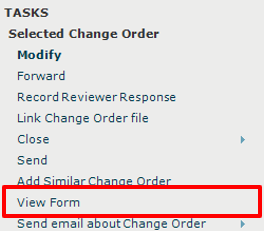
3. The merged change order document appears. You can Print or use the Save As button to save the PDF file. If you want to create the PDF and take the next step at the same time, click the Next Action button and either Forward (for review or signature), or Send and Close. Either of those actions creates a PDF of the change order document and attaches it to the Forward Change Order workflow step.
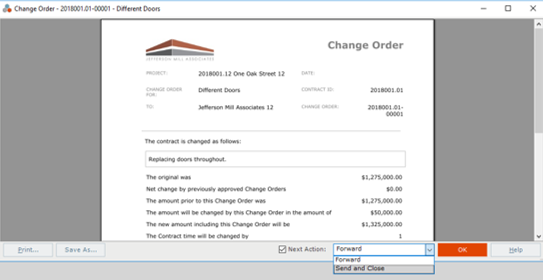
To forward the change order for review or signature
Once the actual change order document is created, saved in your project files, and linked to the change order record, if needed you can use the Forward workflow action to send the document to someone for review or signature before finalizing.
1. Select the change order from the log and click Forward from the Tasks panel.
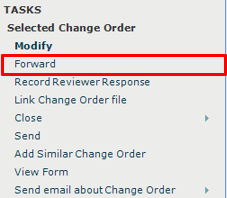
2. The Forward Change Order dialog box opens. Edit any information as needed, include any files on the Files to Send tab, and click the Forward button.
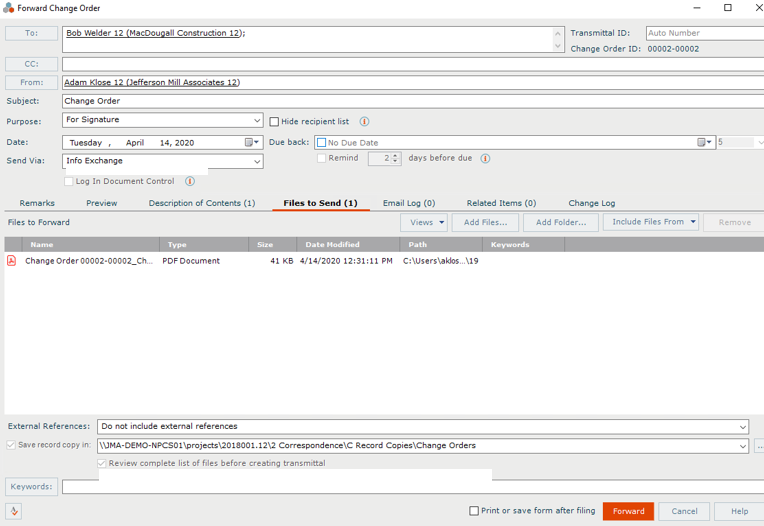
To record the reviewer response for the change order
When the reviewer response is received, it can be recorded as a workflow action for the change order. Review responses can originate from Info Exchange, email, mail, etc., or from internal staff.
1. If internal staff is recording their review, select the change order, click Record Reviewer Response from the Tasks panel, then go to step 3 below.

2. If the review response is coming from Info Exchange, it will be in the Pending Incoming log. Select the incoming response and click Receive Pending Review Response to receive it.

3. The Record Reviewer Response for Change Order dialog box opens. Review the information and click Record Response.

To link the change order file
Once the change order is finalized and signed, you can link the signed, scanned file to the change order record.
1. Select the change order in the log and click Link Change Order File from the Tasks panel. Browse to find and select the file. Or, instead of using this task, you can modify the change order and click the button to the right of the Executed Change Order field to browse and find the file. It will then display on the Preview tab for quick reference.
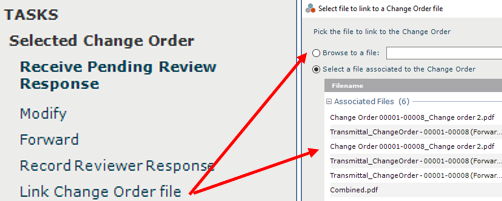
To close (finalize) a change order
After the change order is reviewed, and documents have been signed, you can take the next workflow action to close (finalize) the change order, which may involve sending the finalized change order to the parties affected.
1. If you are sending the change order, select the change order from the log and click Close > Send and Close on the Tasks panel.
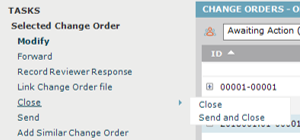
2. If files are attached to the change order, the Select Files to Send dialog box opens. Select the change order document(s) and/or other files to send, select the method (Info Exchange or email), then click OK.
To close (finalize) a potential change order
After the PCO is created, pricing has been requested and then recorded, and any needed change orders are created, you can take the next workflow action to close (finalize) the PCO to indicate that the issue has been resolved.
1. Modify the PCO and change the Status field to Closed, then click OK.

Table of Contents
Index
Search (English only)
Back





